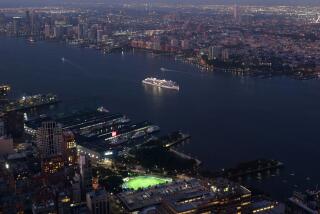Exploring the eastern reaches of European civilization aboard a luxury ship
- Share via
VENICE, Italy — The ship loomed at dockside like a gleaming white apparition. Having taxied the few miles to Athens’ port city of Piraeus, and after much tipping of porters, we passed through the liner’s imposing foyer and climbed the grand staircase en route to our comfortable stateroom. The room, furnished with dark mahogany and brass, had a queen-size bed, private veranda and Jacuzzi, and was large enough for us to entertain a few guests.
My companion, Rosalie, and I had cruised before, on such craft as rust-bucket inter-island steamers plying the Banda Sea in the southern Moluccas. A few years ago we upgraded, enjoying a pleasant sail on the elegant Crystal Harmony from Buenos Aires to San Juan. This time we had chosen the Crystal Symphony, the second and even more lavish of the L.A.-based cruise line’s luxury ships, specifically for its itinerary. With an abbreviated amount of vacation time, we wanted to see and experience the eastern reaches of European civilization, dating from thousands of years ago, that otherwise might have been denied us.
Our 12-day cruise included ports of call in Ephesus, Perga and Aspendus in Turkey, Santorini and Corfu in Greece, and Dubrovnik in Croatia, before disembarkation in Venice. And as veterans of travel in often steamy, rank places, we were ready for a bit of shipboard pampering. With a capacity of 940 passengers, the Symphony is a veritable floating city, with casinos, theaters and restaurants--something for every taste, but with every opportunity for privacy as well as conviviality.
Once aboard the ship, we enjoyed dining alone the first night at our assigned table for 10 in the ship’s main dining room, with its looming chandeliers. The Chilean sea bass, and the crab-and-brie soup that preceded it, were enjoyable, and the prices for good wine hovered at about the $30 mark, so we didn’t feel put upon. But we were curious about who would be our table mates for the rest of the cruise. Assigned seating can be both a blessing and a curse. But with two additional restaurants (specializing in Asian and Italian fare) where one could reserve a table in advance (plus the 24-hour room service option, for caviar within minutes), we figured we could escape any unpleasant dinner companions. We were soon to learn there would be no offenders.
The next morning came in a rush for Rosalie, who did an hour on the treadmill in the well-equipped spa--and a load of laundry--before I could bear to face the day. After a buffet breakfast at the Lido Cafe on the ship’s stern, I swam laps for an hour in the pool above decks as we sailed slowly southeast through islands in the Aegean Sea. It was early last October, and the weather was balmy.
At dinner that night, our new table mates soon became pleasant company: Pam and Paul from Vancouver, Audrey and Jim from Los Angeles, and Ian and Ardith from London (the former at once stuffy and gregarious, and the latter delightfully charming), as well as Jeremy and Jill, who lived outside London. Ian fancied himself a wine aficionado, so we deferred to his selections on most nights. An exception was the following evening, when we were joined by an old friend and California wine expert; her wry opinions of Ian’s wine choices made for some moments of irony and mirth. As amusing as our subsequent dinners aboard were (and the food was almost always superb), they were largely rewards after days in ports and land excursions. After dinner there was a variety of entertainment: the Las Vegas-style floor shows in the Galaxy Lounge, gambling in the casino, perhaps a nightcap in the Avenue Saloon.
We relished the days at sea. Mornings were spent at one of the two pools, with a hamburger or more elaborate buffet for lunch. Afternoons found us walking the promenade deck, watching the shuffleboard players or those on recliners taking the air, and afterward enjoying tea and sandwiches in the informal Palm Court.
But we were really aboard to see places for the first time, and, both being amateur historians, we brought a keen sense of curiosity to places we might never see again. Upon docking in early mornings, we were no more than an hour by bus from any of the ancient capitals of Asia Minor, trade centers that in their day had imported all the riches of the East.
So it was that after anchoring off Kusadasi on the Turkish coast, a market town featuring carpets, leather goods and jewelry at affordable prices, we were bused to the extraordinary remains of Ephesus, the 3,000-year-old port city, now under extensive preservation. We wandered its ruins and ran our hands across its pink and blue marble stones and columns, its remarkable friezes and its mosaic floors. A golden terminus of Eastern trade before Alexander the Great’s death in 323 BC, Ephesus was later to be ruled by the Romans. To walk Ephesus’ marble, colonnade-flanked streets, to admire the astonishing engineering feat of diverting an underground river to feed its public baths and cleanse its toilets, to behold the ruins of the Temple of Hadrian (built in AD 118) is to marvel at the vision and ingenuity of a great age.
The next day’s sky was streaked with gray as we passed between a scattering of Greek islands--Kos, Nisiros and Tilos--before turning east through the Marmaris Strait, which separates the island of Rhodes from the Turkish mainland. We heard a lecture in the Starlight Lounge, preparing us for our next port. By late afternoon we passed several small ports before swinging north for Antalya, the “Jewel of the Turkish Riviera.”
We bypassed the modern city on our way to the ruins at Perga, another ancient port, silted in by the Aksu River so that today it sits a mile and a half from the sea. Dating from Alexander’s time, this city of ruins is reminiscent of Ephesus. Two enormous sandstone towers guard its entrance, whose major thoroughfare is a marble avenue leading to the ruins of the marketplace and a nearby stadium.
We continued on by bus to Aspendus, which legend has it was founded by Greek colonists on their return from the Trojan Wars. The ancient city, now virtually destroyed, ironically boasts a 15,000-seat amphitheater built in the 2nd-century reign of Emperor Marcus Aurelius that is almost completely intact. Great niches in the walls behind the stage once served as resting places for huge statues, while at the theater’s circular top, great arches are supported by faux marble columns. The amphitheater may be one of the most impressive sights in Asia Minor.
After another restful day at sea, which included a wine lecture and tasting led by our California friend, we cruised back into Greek waters. At dawn the ship slid into harbor along the island of Santorini (also known as Thira), about 70 miles north of Crete. Santorini’s deep harbor, beneath the island’s massive, layered gray lava cliffs, offered a view of gleaming white cities perched hundreds of feet above us. The harbor is actually a volcanic crater, a caldera, dating from an eruption about 1500 BC. Ashore, our destination was the archeological dig near the village of Akrotiri, with some of the earliest ruins on the island. We then continued on to various villages with whitewashed, gleaming strings of houses piled one atop the other and accented with stark Aegean blue trim. But it is the sea that defines Santorini, as it was in Alexander’s day, when that ruler used the island as a naval base to control the southern Aegean.
Lunchtime found us in Fira, the island’s capital, at a restaurant called Kokoumavlos, with a magnificent high view of the sea and a memorable meal of local catches and produce to match it. When we were ferried back to the ship under a muted sun, we dressed in formal attire for dinner with our English friends Ian and Ardith and the others. We were liking each other more and more as the days passed and we found ourselves thrown together for our land excursions. One thing soon became clear: Passengers aboard this cruise were there for the experience of new ports. The land excursions, with excellent guides, sold out early.
The deeply green island of Corfu, just off the Albanian coast, greeted us next. For the first time on our trip the air was deliciously cool, despite the immensely bright sunlight that plays off the pastel walls of the old city of Corfu Town. Corfu is an island of plenty, and we found great pleasure wandering its vegetable and seafood markets. We returned to the ship to discover the cruise’s only blight. A computer failure had shut down most of the ship’s electricity, including the elevators and air-conditioning.
But after a tense couple of hours’ delay, the ship was underway, passing through the narrow strait and headed for Dubrovnik. It is a walled city on a hill and the damage from the Bosnian War is almost all repaired, save for the occasional blue-tarped roof where restoration is ongoing. The old port city appears a seemingly impenetrable fortress.
The city’s marble-paved main street is a valley between two urban edges. Narrow streets run off this broader one at right angles, many with outdoor cafes. Everywhere you are reminded that the city’s first love was trade, for the image of a beckoning St. Blaise, the port’s patron saint, greets you at the main gate as well as in its Venetian-style public buildings and churches with their spacious squares and courtyards. But the cruise was winding down, and our earlier elation was now crossed with bittersweetness. On our last day at sea, we awakened to a gray day of cruising the Adriatic, making our way toward Venice, and after dinner that evening, we sensed that a good time does not have a long life.
From my starboard terrace, I watched Venice slide by in the rising mist as we glided down the Grand Canal to our docking in the early morning. A threat of rain hovered over this dark dream of a city. Later we found our hotel on the island of Lido, then ferried back into the city for a requisite drink at Harry’s Bar. By then we were already missing the warm comforts of the Crystal Symphony, and the rain hadn’t even begun.
(BEGIN TEXT OF INFOBOX / INFOGRAPHIC)
GUIDEBOOK
Route to Ruins
Booking the Crystal Symphony: This summer, the ship sails between Rome and Athens May 20-June 1, Sept. 28-Oct. 10 and Oct. 22-Nov.3. Discounted rates (per person, assuming double occupancy) run $5,510 to $5,530 for the lowest-priced staterooms (without veranda). Staterooms with verandas cost about $6,700, and penthouses are $10,695 to $22,360. For the Oct. 22 itinerary, the lowest discounted price falls to $4,080 per person. (On our cruise last fall, we booked one of the penthouses, which were listed in cruise line brochures for $11,100 to $21,800 per person. Our penthouse was in the low end.) Travel agents can often secure a 10% to 15% discount. Prices include all food, but not alcoholic beverages. Silversea Cruises also offers itineraries in the eastern Mediterranean; telephone (800) 722-6655.
For more information: Crystal Cruises, tel. (800) 820-6663, fax (310) 286-9231, or a travel agent specializing in cruises.
More to Read
Sign up for The Wild
We’ll help you find the best places to hike, bike and run, as well as the perfect silent spots for meditation and yoga.
You may occasionally receive promotional content from the Los Angeles Times.






